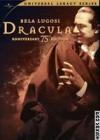Dracula 75th Anniversary (DVD)
When Dracula was being filmed at Universal Studios in 1931, so was Drácula. Drácula is the lesser-known, but no less effective, Spanish cinematic version of Bram Stoker's immortal novel about a Transylvanian count who must drink the blood of others to stay alive forever.
Dracula, directed by Tod Browning and starring Bela Lugosi in the title role, is an undisputed masterpiece and nearly every cinefile on the planet has seen at least some of it. While the Spanish version was rediscovered some years ago, not many horror fans have actually viewed it (I've certainly never seen it on TV).
The movie was shot especially for the Spanish audience, so it employed Spanish-speaking actors and a co-director (Enrique Tovar Ávalos, uncredited) to assist George Melford (who didn't know sangre from si) and a crew that worked on the same sets by night after the American production had wrapped for the day.
I finally got my opportunity to check it out as part of Universal's impressive box-set release of Dracula in honor of its Diamond Anniversary. While both versions are quite similar (they used basically the same script, and the actors hit the same marks), it's fascinating to see the differences.
On the downside, the cinematography is not nearly as polished. While Dracula had a real sense of artistic composition and smooth, steady crane shots and zooms, Drácula is a bit jerky and when we see the three brides in the beginning, they're sort of wandering around rater than putting up a united front; that's typical of the composition… not as thought-out.
Carlos Villarías as the Count has his moments, but his exaggerated facial expressions often come off as pained or campy. Pablo Álvarez Rubio, as the conflicted Renfield, plays the character broader than did Dwight Fry, and Fry's trademark lunatic laugh is definitely missed (though it's good Rubio didn't try to imitate his counterpart). Van Helsing is a bit over the top (but of course, all the acting in both versions is a bit stilted… remember, this is the birth of the "talkies" and most of the players were used the sweeping gestures demanded by the stage).
On the upside, the female characters, Eva (Lupita Tovar) and Lucia (Carmen Guerrero) are stronger and more vibrant. The Spanish version was not held to the Hays Code and, as a consequence, the actresses dress more provocatively and enjoy more playful, candid conversations. There is a lot more between Eva and Count in this version (indeed, it runs nearly a half hour longer than its American counterpart), and we get to actually see some near-bites, the resulting bite-marks, and the point of Van Helsing's stake against Drácula's breast.
Also, the fake bats and spiders look less hokey in the Spanish version, because they're not shown for as long on camera. The real animals, like the opossum, are funnier because rather than slinking around the coffin as they do in the Browning opus, here the critter blindly falls off the dusty lid with an unceremonious "thunk!" Finally, there are rats in this version, whereas the furry vermin were pretty much banned from American movies at the time because audiences found them far too disgusting to see on the big screen.
Disc One:
Dracula — 1931 movie.
Lugosi: The Dark Prince — A noteworthy documentary about Lugosi's career from start to finish, along with comments from industry insiders and film historians, including Joe Dante, Greg Mank, Kim Newman, Ramsey Campbell, Jimmy Sangster, Christopher Wicking, Peter Atkins, and Clive Barker.
Monster Tracks — Pop-up facts about the film, accompanies the entire movie.
The Road to Dracula — Hosted by David J. Skal, this mini-doc is all about the making of both versions of Dracula, repeating many of the speakers from Lugosi: The Dark Prince, but also comments from actress Lupita Tovar, which are quite interesting to hear (she also does an introduction to the movie, on disc two).
Feature Commentary with David J. Skal — This one is a carry-over from an older DVD release.
Feature Commentary with Steve Haberman (screenwriter of Dracula: Dead and Loving It, and the author of several film-related books) — While Haberman looks down his nose at the Spanish version of the film almost constantly throughout his commentary, and while he is clearly reading most of that he says, I did learn a lot. He talks about the psychological aspects of the rise of horror's popularity at the time; artistic influences of Browning and the art director and production designer; and shares actual script notes from Universal's executives in charge of the production.
Score by Philip Glass & The Kronos Quartet — Dracula was made so soon after the silent era of films that it didn't have an original score (it opens and closes with selections by Schubert, Tchaikovsky, and Wagner, while having no musical accompaniment to the timeless tale itself). Now you can watch the movie with an optional score composed by Philip Glass and performed by the Kronos Quartet. It's an interesting idea, but I found the constant bombardment of music overbearing and jarring. The quiet creepiness of the original presentation works a lot better, in my opinion.
Disc Two:
Dracula –1931 Spanish Version Movie.
Universal Horror, 90 minute documentary.
= = =
Reviewed by Staci Layne Wilson



